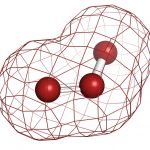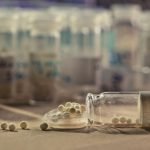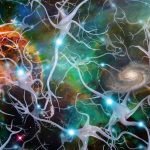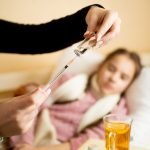Carcinoid: The Zebra Diagnosis
Gurdev Parmar, ND, FABNO and Jacob Schor, ND, FABNO
I found great consolation in reading a case that co-author Gurdev Parmar sent me recently. Discovering that an astute practitioner like Dr. Parmar made the same mistake I once did brings me solace. Here’s a brief of his case:
Feb. 2004: A 59-year-old female, menopausal, G3P3, chief complaints of fatigue, gas and bloating. The gas and bloating improved with digestive enzymes and avoidance of problem foods. Fatigue seemed to improve.
April 2004: Patient returns complaining of depression and hot flashes. Prescribed L-tryptophan, which produced vast improvement in depression. Hormonal treatments alleviated hot flashes.
Aug. 2004: Patient returns with worsening GI symptoms. The depression and menopausal symptoms are still well controlled via prior treatments. Upper and lower GI symptoms have gotten worse, despite continuing enzymes and avoidance of problem foods. O & P negative. The patient was referred to a general practitioner (GP) for upper and lower GI series.
Feb. 2005: The patient returns with worsening fatigue and GI symptoms. The GP had prescribed proton pump inhibitors that the patient wishes to discontinue. The patient tested positive for anti-gliadin antibodies and is now on a gluten-free diet.
Oct. 2005: The patient reports her GI and menopausal symptoms are better, but was in a motor vehicle accident and now complains of multiple musculoskeletal aches and pains. Referred to chiropractor and registered massage therapist.
Jan. 2007: Gastritis is again the chief complaint. Thorough lab investigations ordered, including amylase, LFTs, KFTs, CA 19-9, CEA (Carcinoembryonic antigen), CA-125, etc. All tests, including the prior imaging run by GP and GI specialist that the GP referred, return negative. Continue treating symptomatically.
March 2007: Patient returns with significant weight loss.
June 2007: CT scan shows multiple liver lesions. Patient sent to BC Cancer Agency. It takes an additional 4 months to diagnose a neuroendocrine tumor. She is prescribed octreotide and is living in a residence nursing care facility. The octreotide is not controlling her symptoms.
Carcinoid: “Mimicking” Cancer
For me, this case shows how this particular cancer is a great mimicker; the symptoms are varied and multi-system and can be easily written off as coming from a simpler, more benign diagnosis. The symptoms also appeared to respond to the naturopathic therapies tried, at least temporarily. This further confuses the situation. The Carcinoid Foundation sums up the difficulty in recognizing this type of cancer with the line: “Think zebra, not horse.”
My thought in reading this case was, “Been there, done that.” My patient came to see me at least 12 years ago … a small, spry woman with grey hair, cut short. She coached figure skaters. She complained of severe diarrhea, fatigue and hot flashes. I ran the stool samples, gave her something that maybe helped a little, and something else for her hot flashes. She left a phone message a month later telling me that she had a carcinoid tumor. I was blown away, because this came so out of the blue. I had thought we were on track, doing the right things for her symptoms.
Carcinoid is easy to miss and easy to mistake for something else. Our hope in writing this article and confessing our mistakes is to put this relatively rare cancer back on your differential diagnostic lists. Hopefully you won’t make the same mistake the two of us have.
About Carcinoids
Carcinoids are neuroendocrine tumors. They can originate in any hormone-producing cell of just about any organ. Still, about two-thirds start in the gastrointestinal tract, especially the stomach and intestines. About 10% start in the lungs. It’s possible for carcinoid tumors to originate in the liver, pancreas, testicles or ovaries, but it’s rare. Carcinoid tumors often grow slowly for many years without causing symptoms.
Carcinoid isn’t common; only 11,000 to 12,000 are diagnosed in the U.S. each year. This number is increasing, though, without explanation. There are few known risk factors for developing this sort of cancer. The only known ones are:
- Family history of multiple endocrine neoplasia type I.
- African American descent. GI carcinoid tumors are more common among African Americans than caucasians, and African American men are at a higher risk than their female counterparts.
- Average age at diagnosis of 55 to 65. Children rarely develop carcinoid tumors.
- Other stomach conditions. People with diseases that damage the stomach and reduce acid production are at greater risk of developing stomach carcinoid tumors, especially conditions that affect the stomach’s ability to produce stomach acid, such as atrophic gastritis, pernicious anemia or Zollinger-Ellison syndrome.
Depending on the tissue carcinoid tumors originated from, they will produce different hormones. For example, carcinoids originating in the foregut have low serotonin content but usually secrete 5-hydroxytryptophan (5-HTP) and histamine. These tumors often produce ACTH and can metastasize to bone. In contrast, midgut carcinoids often produce high levels of serotonin (5-hydroxytryptamine or 5-HT), kinins, prostaglandins, substance P and other vasoactive peptides. These tumors rarely produce ACTH, and bone metastasis is rare. Hindgut carcinoids, on the other hand, rarely secrete 5-HT, 5-HTP or any other vasoactive peptides. Therefore, they do not produce the symptoms we typically associate with carcinoids. Because of the wide range of hormones and other proteins these tumors may make, it is difficult to generalize the specific symptoms that may result.
Diagnosing Carcinoid Tumors
Carcinoid tumors often may cause no symptoms for years. They may be diagnosed unexpectedly by a surgeon during an unrelated surgery or on x-rays for another condition.
Depending on the hormones they make, these early-stage tumors can produce a range of symptoms, including:
- Facial flushing
- Diarrhea
- Abdominal pain (caused by blockage of the intestines)
- Asthma
- Rash
- Heart disease
- Intestinal bleeding
- Pellagra (with symptoms of scale-like skin sores, diarrhea and mental disturbances)
- Melena (this usually indicates there is bleeding elsewhere in the gastrointestinal tract)
“Can” is the important word here. Even if the tumors do produce symptoms, they are rarely identified as the cause.
Carcinoid tumors in the lungs may cause more striking symptoms, because the hormones released bypass the liver and enter the bloodstream directly. In addition to hormonal symptoms, lung carcinoid tumors can trigger cough, wheezing and pneumonia. Think about how many patients you have seen with some combination of these three symptoms without ever considering that your patient had a carcinoid tumor
The common wisdom is that over time as these tumors grow in size they produce larger amounts of hormones to the degree that they start to cause regular symptoms. About 60% of people with carcinoid tumors eventually develop carcinoid syndrome (American Society of Clinical Oncology, n.d.). They will present with any of the following symptoms:
- Facial flushing
- Sweating
- Diarrhea
- Shortness of breath
- Wheezing or asthma-like symptoms
- Fast heartbeat
- Heart murmur
- Weight gain
- Weakness
- Secondary diabetes
- Increased body and facial hair
- High blood pressure
- Neurosis (characterized by anxiety and psychosis)
Stress, strenuous exercise, and drinking alcohol may worsen these symptoms.
Tina Kaczor, ND, FABNO offered an interesting explanation for the progression from low-symptom carcinoid to full-blown carcinoid syndrome. She says it’s all about the liver: “… When I was knee-deep researching carcinoid a while back, I came across the explanation for why it is found so late … the symptoms due to the overproduction of hormones and neurotransmitters are largely kept in check by efficient metabolism through the liver in earlier stages of the disease. It takes liver involvement to impair the breakdown of the hormones and neurotransmitters to leave enough in circulation to give flushes and other symptoms.”
Perhaps this is why alcohol will worsen symptoms, and also why these tumors often go undiagnosed until there is significant metastasis to the liver.
As the condition progresses, the syndrome turns to a crisis. A carcinoid crisis is when all of the syndrome symptoms occur at the same time. Carcinoid crisis can usually be prevented and treated with the drug octreotide, a medication that raises blood pressure and limits hormone production.
As Dr. Kaczor seems to have seen quite a few cases of this rare condition, we asked her when she considers carcinoid in her differential diagnosis: “I would suspect carcinoid tumor in patients exhibiting multiple symptoms of the disease. Anxiety, a sense of “fullness” in the abdomen with the absence of gas on exam, certainly hot flushes or reddening of the face as witnessed by friends/family, and diarrhea/constipation. I have one woman who went several years with IBS, and she felt strongly that there was “something” in there – a feeling that there is a mass is not unusual. The problem, of course, is that the symptoms are really difficult to differentiate in women with possible menopausal symptoms.
“Since IBS is a diagnosis of exclusion, I would consider blood work for carcinoid in patients that do not respond to naturopathic treatments for IBS and in whom all naturopathic diagnoses have been checked out, too (i.e., dysbiosis). I think it is a golden rule of practice: If a treatment is not working (and has in the past), reassessment of the condition must be done.”
The classic diagnostic tests for carcinoid are urine 5-hydroxyindoleacetic acid (5-HIAA) and serum chromogranin A. The latter is a general marker for neuroendocrine tumors. Serotonin is measured in the urine as 5-HIAA. High levels of 5-HIAA suggest carcinoid syndrome or carcinoid crisis.
Dr. Kaczor says: “My sequence of tests: chromogranin A; urinary 5-HIAA; PSA if the patient is male, since chromogranin A is also elevated in prostate cancer; plus routine tests. If the chromogranin A is high, then order an abdominal x-ray. If the x-ray is negative, then order an ultrasound of the abdomen with attention to liver. If the 5-HIAA is high, refer the patient to a gastroenterologist for the full workup.”
Treatment
Many carcinoid tumors are treated surgically. If possible, the entire tumor is removed. If not, a debulking surgery is performed, removing as much of the tumor as possible, as this can provide some symptom relief. External-beam radiation therapy is often used to treat bone metastases in order to relieve symptoms. Chemotherapy is used when the tumor has spread to other organs or is causing severe symptoms. Carcinoid tumors rarely respond to chemotherapy alone.
Carcinoid can cause niacin deficiency, at least in patients making elevated levels of serotonin or 5-HTP. If all of the tryptophan in the body is being diverted to make serotonin, little is left to make niacin. Niacin supplementation will ease the symptoms of deficiency, but will not change the course of the disease (Shah et al., 2005).
Countless websites post this same line: “Fish oil capsules, electrolyte supplements and, in some cases, large portions of nutmeg may be recommended for those suffering from carcinoid.” Though a time-honored treatment for carcinoid, we are unable to find published peer-reviewed support for using nutmeg. The oft-suggested dose is 1tsp tid. There are reports in the literature of recreational abusers of nutmeg ending up in emergency rooms with “nutmeg poisoning,” though most writers assure us that the tablespoon per day in divided doses usually suggested for carcinoid symptoms is well tolerated (Sangalli and Chiang, 2000).
Heather Paulson, ND, who practices at the Goshen Center for Cancer Care, says “… the things I have personally seen helpful include typical naturopathic adrenal support and anything that helps decrease cortisol.” She says she is fond of a combination product containing ashwaghanda, l-theanine, Magnolia, Epimedium and phosphatidylserine, as it is “very helpful in getting people with carcinoid tumors to sleep.”
The most important thing to remember is that this disease is the “zebra,” the last thing you would expect given the symptoms. Our point, though, in writing this short article is not to focus on treatment or the fine details of diagnosis. We are simply sharing our blunders in failing to think of carcinoid; hopefully you will recall our folly and not make the same mistake.
The Oncology Association of Naturopathic Physicians (OncANP) was founded in 2004 to enhance the quality of life of people living with cancer through both increasing the collaboration between NDs working with patients with cancer and integrating naturopathic practice into medical oncology care. With its co-organization, the American Board of Naturopathic Oncology (ABNO), the OncANP has set standards, instituted testing and now credentials Fellows in Naturopathic Oncology. The OncANP welcomes all NDs interested in improving their knowledge and ability to work with oncology patients. For more information see www.OncANP.org.
Gurdev Parmar, ND FABNO co-founded Integrated Health Clinic in 2000, one of the largest integrated health care facilities in Canada. Dr. Parmar focuses on the treatment of cancer with a fellowship with the ABNO. He is a member of ASCO and OncANP. He lectures regularly for the Canadian Cancer Society and other cancer-related organizations. Dr. Parmar founded The HELP Foundation, which, after the tsunami of 2004 built an Integrated Health Clinic on the island of Kho Khao, Thailand (www.thehelpfoundation.ca). He is licensed in both British Columbia and Arizona. He serves as co-chair of the Advisory Committee on Disaster and Pandemic Preparedness for the province of B.C. In his spare time, Dr. Parmar is a competitive tennis player and enthusiastic Canuck fan. His wife and clinic partner, Karen, and his two sons, Seth and Devan, keep his life balanced and whole.
 Jacob Schor, ND, FABNO is a 1991 graduate of NCNM and has practiced in Denver for the past 17 years. He served as president of the CANP from 1992 to 1999. He has served on the board of directors of the OncANP since 2006 and currently acts as secretary to the board. He is a Fellow of the ABNO. He was utterly shocked and humbled at the 2008 convention of the AANP to be presented with the Vis Award, an honor bestowed in the memory of William Mitchell. He is incredibly lucky to practice with his wife, Rena Bloom, ND. Dr. Schor writes newsletters for his patients that are popular with doctors and students alike in our profession.
Jacob Schor, ND, FABNO is a 1991 graduate of NCNM and has practiced in Denver for the past 17 years. He served as president of the CANP from 1992 to 1999. He has served on the board of directors of the OncANP since 2006 and currently acts as secretary to the board. He is a Fellow of the ABNO. He was utterly shocked and humbled at the 2008 convention of the AANP to be presented with the Vis Award, an honor bestowed in the memory of William Mitchell. He is incredibly lucky to practice with his wife, Rena Bloom, ND. Dr. Schor writes newsletters for his patients that are popular with doctors and students alike in our profession.
References
American Society of Clinical Oncology: Carcinoid tumor – symptoms. Available at: www.cancer.net/patient/Cancer+Types/Carcinoid+Tumor.
The Carcinoid Cancer Foundation: Awareness of carinoid and related neuroendocrine tumor (net) cancers is not where it should be. Available: www.carcinoid.org/support/docs/UnfinishedSaga.pdf.
Shah GM et al: Biochemical assessment of niacin deficiency among carcinoid cancer patients, Am J Gastroenterol Oct;100(10):2307-14, 2005.
Sangalli BC and Chiang W: Toxicology of nutmeg abuse, J Toxicol Clin Toxicol 38(6):671-8, 2000.










